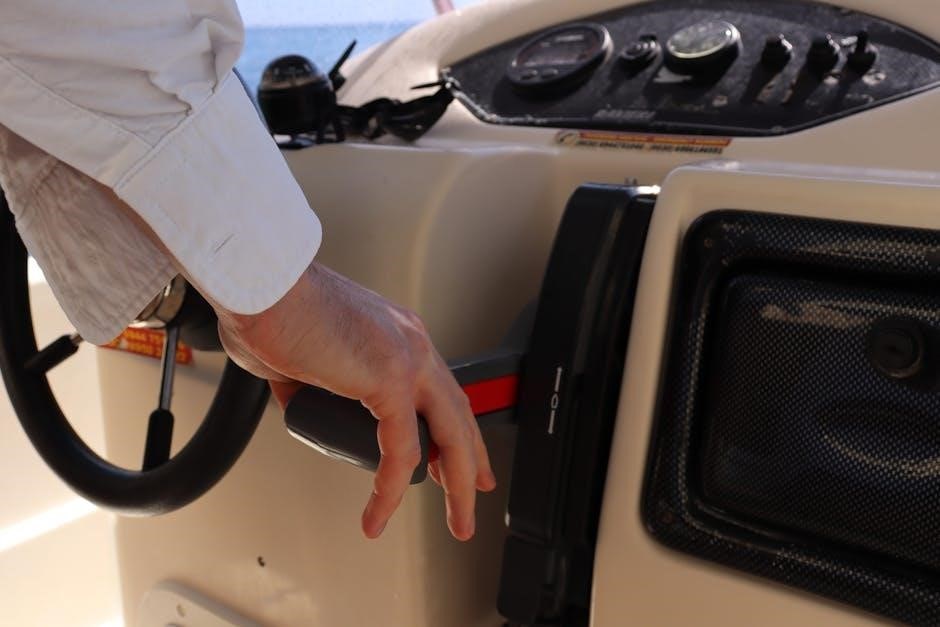The Ohio CDL Manual is an essential guide for obtaining a Driver’s License, covering Ohio laws, regulations, and exam preparation. It aids safe driving and compliance with Ohio’s CDL standards.
1.1 Purpose of the Manual
The Ohio CDL Manual serves as a comprehensive guide for individuals seeking a Commercial Driver’s License in Ohio. Its primary purpose is to provide detailed information about state-specific laws, regulations, and requirements for obtaining and maintaining a CDL. The manual outlines eligibility criteria, licensing procedures, and essential safety practices to ensure drivers operate commercial vehicles responsibly. It also acts as a study resource for the CDL exams, covering topics such as vehicle inspections, traffic laws, and safe driving techniques. By adhering to the manual, applicants can better understand Ohio’s CDL process and prepare effectively for their exams.
1.2 Importance of the CDL in Ohio
The Commercial Driver’s License (CDL) plays a crucial role in ensuring the safe operation of large vehicles in Ohio. It is essential for individuals seeking to drive trucks, buses, or hazardous material carriers. Obtaining a CDL demonstrates a driver’s ability to operate complex vehicles safely and efficiently. The CDL program in Ohio is designed to uphold high safety standards, reducing the risk of accidents involving commercial vehicles. Additionally, it supports the state’s economy by providing qualified drivers for the transportation industry. The CDL also offers career opportunities in logistics, construction, and public transportation, making it a vital credential for many professionals in Ohio.

Eligibility Requirements for a CDL in Ohio
This section outlines the criteria for obtaining a CDL in Ohio, including age, residency, medical, and legal requirements, ensuring safe and compliant operation of commercial vehicles.
2.1 Age Requirements
In Ohio, the minimum age to apply for a Commercial Driver’s License (CDL) is 18 years old for intrastate commerce and 21 years old for interstate commerce. For intrastate drivers, you must be at least 18 to operate a commercial vehicle within Ohio borders, while interstate drivers must be 21 to cross state lines. Applicants under 21 are restricted to intrastate operations only. Additionally, all CDL applicants must hold a valid Ohio driver’s license and meet residency requirements. These age requirements ensure safety and compliance with federal and state regulations.
2.2 Residency Requirements
To apply for a CDL in Ohio, you must meet specific residency requirements. You are required to provide proof of Ohio residency, such as a utility bill, lease agreement, or other documents showing your domicile. Applicants must be at least 18 years old for intrastate driving or 21 for interstate commerce. Non-citizens must provide valid immigration documents. Ohio residency is essential to qualify for a state-issued CDL. You must submit two forms of identification and proof of residency when applying. Failure to meet these requirements will result in your application being denied. Always ensure your information is up-to-date with the Ohio BMV.
2.3 Medical Certification
Medical certification is a critical step in obtaining a CDL in Ohio. Applicants must pass a physical exam by an FMCSA-certified medical examiner to ensure they meet health standards for safe driving. The exam evaluates vision, hearing, blood pressure, and physical ability to operate a commercial vehicle. A valid Medical Examiner’s Certificate must be submitted with the CDL application. Certificates are typically valid for up to two years, depending on health conditions. Failure to meet medical requirements can result in CDL disqualification. Regular medical evaluations are required to maintain certification and ensure ongoing fitness for commercial driving responsibilities.

Types of CDL Licenses in Ohio
The Ohio CDL Manual outlines three primary classes of commercial licenses: Class A, Class B, and Class C, each requiring specific vehicle operation knowledge and skills.
3.1 Class A CDL
A Class A CDL in Ohio allows drivers to operate combination vehicles with a trailer in tow, such as tractor-trailers and large trucks. These vehicles have a gross combination weight rating (GCW) of 26,001 pounds or more. The Class A CDL is essential for drivers seeking careers in long-haul trucking, construction, and other industries requiring heavy machinery transport. It enables operation of vehicles with detachable trailers and is considered the most comprehensive CDL category in Ohio. This license demonstrates a driver’s ability to safely manage complex and heavy vehicles, making it a critical credential for professional truck drivers.
3.2 Class B CDL
A Class B CDL in Ohio allows drivers to operate heavy straight trucks, buses, and other vehicles with a gross vehicle weight rating (GVWR) over 26,001 pounds. This includes city buses, tourist buses, and large delivery trucks. A Class B license does not permit the operation of combination vehicles like tractor-trailers, which require a Class A CDL. Drivers must be at least 21 years old to apply for a Class B CDL, though intrastate commerce may allow 18-year-olds under certain conditions. This license is crucial for those seeking careers in public transportation, construction, or delivery services.
3.3 Class C CDL
A Class C CDL in Ohio is designed for operating small passenger vehicles or hazardous materials (HazMat) transport. It allows drivers to operate vehicles with a GVWR less than 26,001 pounds but can include passenger vehicles like small buses or shuttle vans. Eligibility requires drivers to be at least 21 years old for interstate commerce and pass a physical exam. Endorsements such as H (HazMat) or P (passenger) may be needed depending on the vehicle type. Applicants must complete a knowledge test and skills test specific to the Class C CDL requirements.

CDL Endorsements and Restrictions
CDL endorsements and restrictions in Ohio define the types of vehicles you can operate and any limitations. They ensure safe and legal commercial driving practices statewide.
4.1 Endorsements Overview
Endorsements are additional qualifications added to a CDL, allowing drivers to operate specific vehicle types or transport certain goods. They enhance career opportunities by demonstrating specialized skills. Common examples include hauling hazardous materials or operating tank vehicles. Each endorsement requires passing a written test and, in some cases, a background check. Endorsements are critical for drivers seeking to expand their employment options in specialized fields. They must be renewed along with the CDL and are subject to federal and state regulations. Proper endorsements ensure compliance with safety standards and legal requirements for specific cargo or vehicle operations.
4.2 Common Endorsements in Ohio
In Ohio, common CDL endorsements include the H endorsement for hazardous materials, N for tank vehicles, P for passenger vehicles, S for school buses, and T for double or triple trailers. These endorsements allow drivers to operate specialized vehicles or carry specific cargo, enhancing job opportunities. Obtaining these requires additional knowledge and skills tests, with the H endorsement also mandating a background check. These endorsements are crucial for drivers seeking to expand their career options in industries like transportation, education, and public transit.
4.3 Restrictions on CDL Licenses
CDL licenses in Ohio may include restrictions that limit driving privileges based on vehicle type, equipment, or driver qualifications. These restrictions ensure safe operation and compliance with regulations. Common restrictions include air brake restrictions for drivers who cannot operate air-brake-equipped vehicles and passenger vehicle restrictions for those unauthorized to transport passengers. Additionally, trailer restrictions may apply to drivers who cannot operate combination vehicles. These restrictions are typically denoted by specific codes on the CDL. Drivers can often remove restrictions by passing additional tests or providing required documentation. Understanding and adhering to these restrictions is crucial for maintaining a valid CDL in Ohio.

Study Materials for the CDL Exam
The Ohio CDL Manual is the primary study material, offering detailed information on state-specific laws, regulations, and exam topics. Additional resources include online practice tests and study guides.
5.1 The Official Ohio CDL Manual
The Official Ohio CDL Manual is the primary study resource for individuals seeking a Commercial Driver’s License in Ohio. It provides detailed information on Ohio’s CDL requirements, including classifications, endorsements, and medical certification. The manual covers state-specific laws, safe driving practices, and exam preparation tips. It also includes sections on pre-trip inspections, vehicle control, and on-road driving skills. Available online or at local BMV offices, the manual is a comprehensive guide to help applicants prepare for both the knowledge and skills tests. It is regularly updated to reflect current Ohio CDL regulations and standards.
5.2 Additional Study Resources
Besides the official manual, Ohio CDL applicants can utilize online practice tests, CDL prep courses, and mobile apps for exam preparation. Online forums and YouTube tutorials also provide valuable insights and tips. Many driving schools offer study materials and practice exams tailored to Ohio’s specific requirements. Additionally, some websites offer interactive tools to help memorize regulations and signage. These resources complement the manual, ensuring a comprehensive understanding of the material. Leveraging these tools can significantly improve readiness for both the knowledge and skills tests.

The CDL Application Process in Ohio
The CDL application process in Ohio involves several steps, including submitting required documents, paying fees, and completing necessary tests to obtain a commercial driver’s license.
6.1 Steps to Apply for a CDL
To apply for a CDL in Ohio, start by visiting the Ohio BMV website to download the CDL application form. Complete the form accurately and gather required documents, such as proof of identity, residency, and medical certification. Schedule a physical exam with a certified medical examiner to obtain a Medical Examiner’s Certificate. Submit your application and fees at a BMV office. Next, study the Ohio CDL Manual to prepare for the written knowledge test. Once you pass the written test, schedule and pass the skills test, which includes a pre-trip inspection, basic vehicle control, and on-road driving. Upon successful completion, you will be issued your CDL.
6.2 Required Documents
To apply for a CDL in Ohio, you must provide specific documents. These include proof of identity, Social Security number, and Ohio residency. You will need to submit one proof of identity, such as a valid passport or birth certificate, and two proofs of residency, like utility bills or lease agreements. Additionally, you must provide a valid Medical Examiner’s Certificate if required for your CDL class. Veterans may also need to submit a DD-214 form for eligibility. Ensure all documents are valid and meet the Ohio Bureau of Motor Vehicles (BMV) requirements. Check the BMV website for the most accurate and updated list.
6.3 Fees Associated with CDL Application
Applying for a CDL in Ohio involves various fees, which may vary based on the license class and endorsements. The base fee for a Class A CDL is typically around $42, while Class B and C licenses are slightly lower. Endorsements, such as Hazmat or Tanker, cost additional fees, ranging from $5 to $50 each. A $15 application fee is also required. Payment can be made via cash, credit card, or check. It’s important to verify current fees with the Ohio Bureau of Motor Vehicles (BMV) before applying, as costs are subject to change.

Preparing for the CDL Exam
Preparing for the CDL exam involves careful review of the Ohio CDL Manual, focusing on key topics and practicing with sample tests to ensure readiness and confidence.
7.1 Understanding the Exam Format
The Ohio CDL exam is divided into a written knowledge test and a skills test. The knowledge test assesses understanding of trucking laws, safety practices, and vehicle operation. It includes multiple-choice questions covering general knowledge, combination vehicles, air brakes, and endorsement-specific topics. The skills test evaluates practical abilities through a pre-trip inspection, basic vehicle control, and on-road driving. Familiarizing yourself with the format helps reduce anxiety and ensures better preparation. Understanding each section’s requirements is crucial for success.
- Knowledge test: Multiple-choice questions on regulations and safety.
- Skills test: Practical demonstration of driving and inspection skills.
7.2 Practice Tests and Resources
Practice tests are a crucial part of CDL exam preparation. The Ohio CDL Manual provides sample questions to help familiarize applicants with the exam format. Additional resources include online practice tests, mobile apps, and study guides. These tools focus on areas like general knowledge, endorsements, and safe driving practices. Utilizing these resources helps improve understanding and reduces test-day anxiety. Many websites offer interactive tests, while CDL training schools provide access to exclusive materials. Consistent practice ensures readiness for both the knowledge and skills tests, boosting confidence and performance. Leveraging these resources is essential for success in obtaining a CDL in Ohio.

The CDL Knowledge Test
The CDL Knowledge Test assesses understanding of safe driving practices, traffic laws, and vehicle operation. It’s a written exam ensuring drivers can operate safely and legally in Ohio.
8.1 General Knowledge Test
The General Knowledge Test is a mandatory exam for all CDL applicants in Ohio, covering essential topics like traffic laws, road signs, safe driving practices, and vehicle inspection. It assesses a driver’s understanding of critical safety protocols and regulatory requirements. The test includes questions on cargo management, emergency procedures, and pre-trip inspections. Applicants must score at least 80% to pass. The Ohio CDL Manual serves as the primary study resource, ensuring drivers are well-prepared for the exam. Practice tests are also recommended to familiarize oneself with the format and content. Proper preparation is crucial for achieving a high score and safe driving practices.
8.2 Endorsement-Specific Tests
Endorsement-specific tests are required for drivers seeking specialized certifications, such as hauling hazardous materials or operating tank vehicles. These tests assess knowledge of unique safety protocols, legal requirements, and operational procedures. For example, the HAZMAT endorsement test covers handling and transporting hazardous materials safely, while the Tank Vehicle endorsement focuses on the challenges of liquid cargo. Each endorsement test is tailored to the specific type of cargo or vehicle, ensuring drivers are fully prepared for the responsibilities associated with their certification. Preparation involves studying the Ohio CDL Manual and understanding endorsement-specific regulations.

The CDL Skills Test
The CDL Skills Test evaluates a driver’s ability to operate a commercial vehicle safely. It includes a pre-trip inspection, basic vehicle control, and on-road driving assessment, ensuring competence and mastery of safe operating skills.
9.1 Pre-Trip Inspection
The pre-trip inspection is a critical step before operating a commercial vehicle. It ensures the vehicle is safe and roadworthy, reducing the risk of accidents. Drivers must check tires, brakes, lights, mirrors, and fluid levels. The inspection also includes examining the coupling devices, hydraulic systems, and emergency equipment. This step is part of the CDL skills test and demonstrates the driver’s ability to identify potential issues. A thorough pre-trip inspection is essential for compliance with safety regulations and reflects a professional commitment to safe driving practices. Regular inspections help maintain vehicle reliability and prevent breakdowns during transit.
9.2 Basic Vehicle Control
Basic Vehicle Control tests a driver’s ability to maneuver a commercial vehicle safely and precisely. This includes exercises such as straight-line backing, offset backing, and alley docking. These tasks assess coordination, spatial awareness, and control; Proper alignment and use of mirrors are crucial. The exam evaluates how well drivers can position their vehicle accurately. Mastering these skills is essential for safe operation on public roads and builds the foundation for more complex driving maneuvers. Practice in a controlled environment is recommended to ensure proficiency and confidence behind the wheel.
9.3 On-Road Driving
The on-road driving test evaluates your ability to operate a commercial vehicle safely in real traffic conditions. It assesses skills such as turning, merging, stopping, and lane changes. You must demonstrate adherence to traffic laws, including speed limits and right-of-way rules. The examiner will observe your ability to maintain a safe following distance and react appropriately to hazards. Specific maneuvers, like navigating intersections and roundabouts, may be included. This phase tests your ability to control the vehicle smoothly and make sound decisions while driving in various road environments, ensuring you can handle the vehicle confidently and safely.
After Passing the CDL Exam
After passing the CDL exam, you will receive your commercial driver’s license, granting legal authorization to operate commercial vehicles in Ohio. Next steps include maintaining licensure and adhering to state regulations.
10.1 Receiving Your CDL
After passing the required exams and completing all application steps, you will be issued your Ohio CDL. The license will be mailed to you, typically within 10-14 business days. Ensure all information on your CDL is accurate, including your name, address, and license classifications. Your CDL will include endorsements for which you are qualified, such as hazmat or passenger transport. Keep your CDL with you at all times while operating a commercial vehicle. Receiving your CDL marks the completion of your application process and grants you the legal authority to drive commercially in Ohio.
10.2 Next Steps After Obtaining Your CDL
After obtaining your CDL, it is important to understand your responsibilities as a licensed commercial driver. Maintain a clean driving record, adhere to Ohio’s CDL regulations, and stay updated on medical certifications. Regularly review and comply with Ohio’s specific laws and industry standards. Complete any required ongoing training to enhance safety and efficiency. Keep your CDL updated with address changes or additional endorsements. Familiarize yourself with pre-trip and post-trip inspection procedures. Consider joining professional organizations for networking and resources. Always carry your CDL and medical card while driving. Stay informed about updates to Ohio’s CDL manual and regulations.

Maintaining Your CDL License
Maintaining your CDL requires regular updates, medical certification, and adherence to Ohio’s safety standards. Ensure timely renewals and stay informed about licensing requirements to avoid penalties.
11.1 Renewal Process
To renew a CDL in Ohio, drivers must submit an application prior to the license expiration date. The renewal process typically requires a completed application, payment of fees, and updated medical certification. Drivers must also pass a vision test and, if applicable, provide proof of legal presence in the U.S. If endorsements are being maintained or added, additional testing may be required. It is important to check with the Ohio Bureau of Motor Vehicles (BMV) for specific renewal requirements, as they may vary based on individual circumstances or endorsements. Renewal ensures continuous compliance with state and federal regulations.
11.2 Keeping Your CDL Valid
To keep your CDL valid, ensure compliance with medical certification requirements and maintain a clean driving record. Stay updated on license renewal deadlines and adhere to traffic laws to avoid points or disqualifications. Regularly monitor your driving record for accuracy and address any issues promptly. Additionally, stay physically and mentally fit to meet DOT standards. Familiarize yourself with Ohio-specific regulations and updates to avoid unintended violations. Proactive management of these aspects ensures uninterrupted CDL validity and continued driving privileges in Ohio.
CDL Violations and Penalties
CDL violations in Ohio include reckless driving, speeding, and DUI, leading to penalties such as fines, license suspension, and potential job loss. Penalties vary by severity.
12.1 Common Violations
Common violations for CDL holders in Ohio include speeding, reckless driving, hours of service violations, and improper lane changes; Other violations include operating an overweight vehicle, equipment violations, and failure to maintain proper documentation. CDL drivers are held to a higher standard, and even minor infractions can lead to penalties. Violations such as driving under the influence, texting while driving, or failing to conduct pre-trip inspections are also prevalent. These actions jeopardize public safety and can result in fines, license suspension, or disqualification. Staying informed about Ohio’s specific regulations helps drivers avoid these common mistakes and maintain compliance.
12.2 Consequences of Violations
Violations of CDL regulations in Ohio can lead to severe consequences, including fines, suspension, or disqualification of your CDL. Accumulating points on your license can result in mandatory suspensions. Severe offenses, such as DUI or reckless driving, may lead to criminal charges and CDL disqualification. Employers often terminate drivers with suspended or disqualified licenses, impacting your livelihood. Repeat violations can lead to permanent loss of your CDL, making it difficult to find employment in the trucking industry. Additionally, insurance rates may increase, and your driving record could be permanently affected, limiting future career opportunities in transportation;
Special Considerations for Ohio CDL Holders
Ohio CDL holders must adhere to state-specific regulations, including unique laws, additional safety protocols, and regional requirements. Staying informed through the Ohio DMV ensures full compliance and safe operations.
13.1 Ohio-Specific Laws
Ohio has specific laws governing commercial driver’s licenses (CDLs) to ensure safety and compliance. These laws include regulations on vehicle size and weight limits, hours of service, and cargo restrictions. Ohio also enforces strict penalties for violations, such as driving under the influence or reckless endangerment. Additionally, Ohio requires CDL holders to adhere to state-specific traffic laws, including rules for hazardous materials transportation and school bus operations. Understanding these laws is crucial for maintaining compliance and avoiding legal consequences. The Ohio Revised Code and Ohio Department of Transportation provide detailed resources for CDL holders to stay informed.
- Size and weight restrictions
- Hazmat transportation rules
- Hours of service regulations
- Strict penalties for violations
13.2 Regional Differences
In Ohio, regional differences may influence CDL requirements and practices. Urban areas like Columbus and Cleveland often have specific traffic rules due to higher congestion, while rural areas may prioritize agricultural transportation. Additionally, proximity to major highways and interstate routes can affect hauling regulations. CDL holders should be aware of local ordinances, as some counties may enforce stricter weight limits or parking restrictions. Understanding these regional variations is crucial for compliant and efficient operation across Ohio’s diverse landscapes and transportation networks.
13.4 Additional Resources for Ohio Drivers
Beyond the manual, Ohio drivers can access additional resources to enhance their knowledge and skills. The Ohio Bureau of Motor Vehicles (BMV) website offers downloadable forms, practice tests, and updated regulations. Local driving schools provide hands-on training and tips for mastering the CDL exam. Online forums and state-specific blogs share real-world experiences and advice. Safety organizations, such as the Ohio Highway Patrol, offer workshops on road safety and compliance. Mobile apps like CDL Prep and Trucking Truth assist with test preparation and tracking progress. These resources ensure Ohio CDL holders stay informed, compliant, and skilled on the road.
The Ohio CDL Manual serves as a comprehensive guide for drivers seeking to obtain or maintain a commercial driver’s license in the state. It outlines regulations, safety practices, and exam preparation, ensuring compliance with federal and state standards. By following the manual, drivers can gain the knowledge and skills necessary to operate commercial vehicles safely and efficiently. Additionally, it provides valuable resources for employers and educators to support CDL holders. Staying informed and adhering to the guidelines in this manual is crucial for maintaining a valid CDL and contributing to road safety in Ohio.
